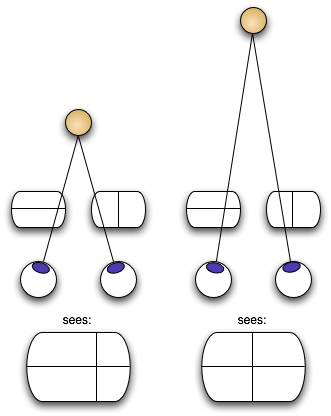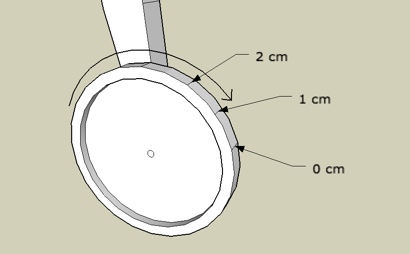Devices for measuring distance
When I was a kid, I was very interested in the problem of measuring physical lengths and distances. My parents had bought me the book The Way Things Work by David Macaulay (the first version came out in 1988 when I was 9), and it inspired the inventor in me. Another catalyst here was the realization that rulers were incredibly impractical for highly curved surfaces or very long distances. Here are two ideas I had back then.
Idea 1: Scaled glasses.
The key advantage here is amazing ease-of-use. One simply puts on a pair of these glasses and looks at the object to discover the distance thereto. The principle is that, when focusing on an object, the angle between our eyes adjusts according to how far away it is. It also utilizes the way in which our brains combine the two images from each eye. (Please see the figures for more explanation.)


idea 1
The drawback of this idea is its coarseness. As objects become farther away, the change in angle between our eyes becomes miniscule. For practical purposes, I would guess that most people could estimate distances about as well as these glasses could indicate (although I have yet to build a prototype to test this out). Still the idea is kind of cool.
Idea 2: The pizza cutter.
Start with a pizza cutter with a blunt edge marked according to distances along the circumference of the wheel. This gives an easy way to measure small distances. The problem is that distances longer than the circumference will cause the marks on the wheel to repeat, forcing the user to remember how many full rotations occurred in order to make an accurate measurement.

start of idea 2
Here's a partial solution to that problem: cut a spiral slice out of the wheel and insert a tab into the spiral. The tab is attached to the handle but allowed vertical freedom (oh, joyous vertical freedom!) As the wheel turns, the tab moves within the spiral, tracking how far the edge of the wheel has traveled, even when the distance is several times larger than the circumference. This device is very easy to use, relatively accurate on distances of a few cm (or inches) up to potentially several meters (maybe 12 feet), and cheap and easy to manufacture. I think one could even build a working model out of heavy paper, a brass fastener, and a rubber band.

idea 2
Finally, it is worth mentioning that a more sophisticated version of idea 2 could use a very small wheel built into a pen-like device with a gear connecting to a digit display similar to that used as a (non-digital) odometer in many cars. This would improve the durability, maximum distance measurable, and ease-of-reseting over the last design.
Idea 1: Scaled glasses.
The key advantage here is amazing ease-of-use. One simply puts on a pair of these glasses and looks at the object to discover the distance thereto. The principle is that, when focusing on an object, the angle between our eyes adjusts according to how far away it is. It also utilizes the way in which our brains combine the two images from each eye. (Please see the figures for more explanation.)


idea 1
The drawback of this idea is its coarseness. As objects become farther away, the change in angle between our eyes becomes miniscule. For practical purposes, I would guess that most people could estimate distances about as well as these glasses could indicate (although I have yet to build a prototype to test this out). Still the idea is kind of cool.
Idea 2: The pizza cutter.
Start with a pizza cutter with a blunt edge marked according to distances along the circumference of the wheel. This gives an easy way to measure small distances. The problem is that distances longer than the circumference will cause the marks on the wheel to repeat, forcing the user to remember how many full rotations occurred in order to make an accurate measurement.

start of idea 2
Here's a partial solution to that problem: cut a spiral slice out of the wheel and insert a tab into the spiral. The tab is attached to the handle but allowed vertical freedom (oh, joyous vertical freedom!) As the wheel turns, the tab moves within the spiral, tracking how far the edge of the wheel has traveled, even when the distance is several times larger than the circumference. This device is very easy to use, relatively accurate on distances of a few cm (or inches) up to potentially several meters (maybe 12 feet), and cheap and easy to manufacture. I think one could even build a working model out of heavy paper, a brass fastener, and a rubber band.

idea 2
Finally, it is worth mentioning that a more sophisticated version of idea 2 could use a very small wheel built into a pen-like device with a gear connecting to a digit display similar to that used as a (non-digital) odometer in many cars. This would improve the durability, maximum distance measurable, and ease-of-reseting over the last design.


1 Comments:
Great work man you have post a great post it will help people very much keep it do more for people like that Forex Trader - Learn the Secrets of Forex Trading.
Post a Comment
<< Home